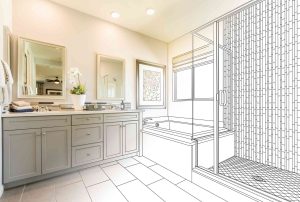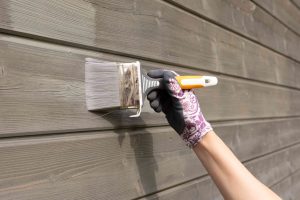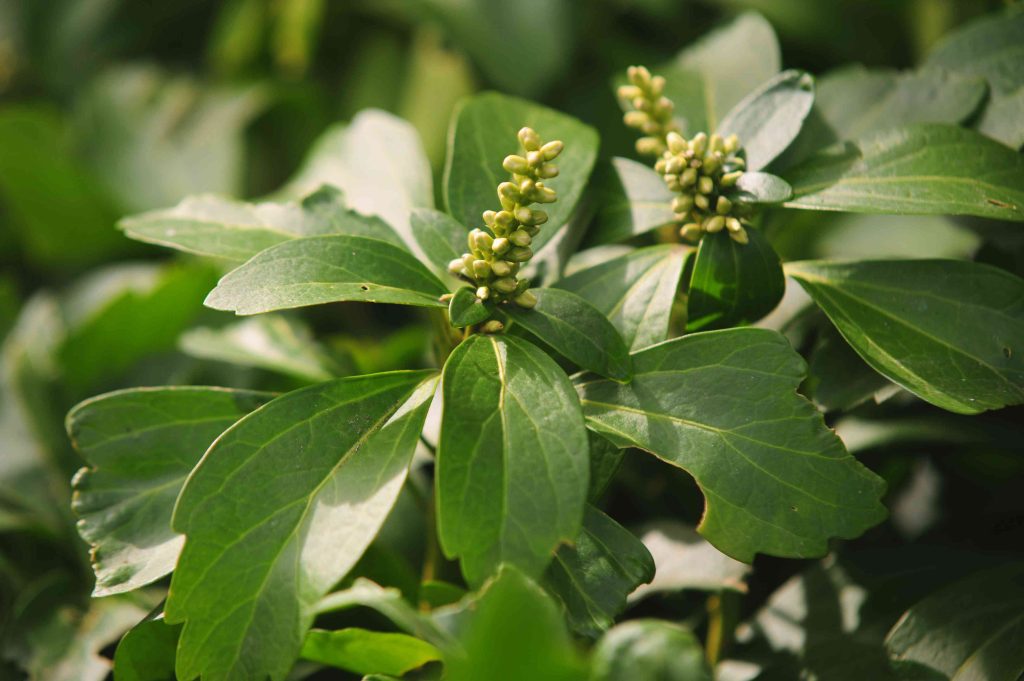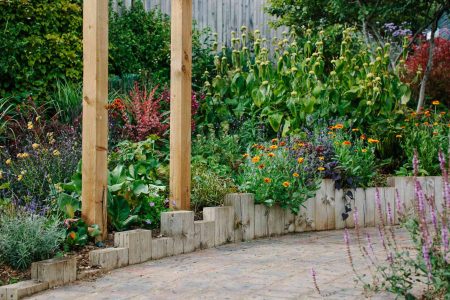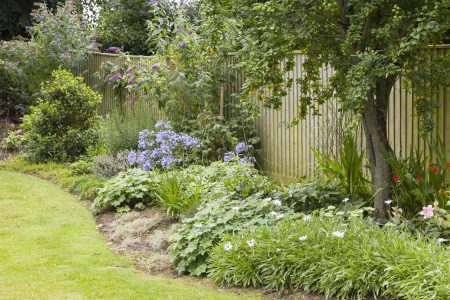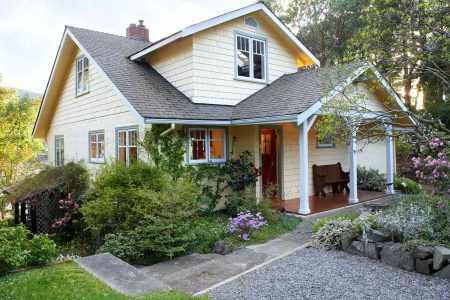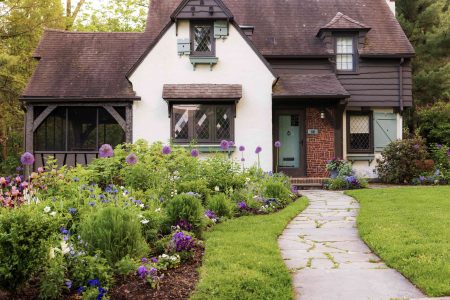An evergreen ground cover plant is beneficial to your garden in two ways. Evergreen foliage provides visual interest all year round. Ground covers offer a number of ways to lower yard maintenance. They fight erosion and suppress weeds. Grown on a slope instead of grass, they help you avoid mowing in a problem area that, at best, would be inconvenient to mow and, at worst, downright dangerous.
Ornamental plants that work as ground covers and bear evergreen or semi-evergreen can be considered some of the best plants for landscaping. And as gardeners, we value them even more if they grow rapidly. That, unfortunately, is the caveat of fast-growing ground covers. Some species, especially non-native ones, can be invasive. If you decide to plant them, be prepared to control their spread, otherwise these plants can do more harm than good in your landscape (and beyond).
Here is a list of the best evergreen ground covers, both herbaceous perennials and low-growing shrubs.
-
01
of 15Creeping Myrtle
Periwinkle, as creeping myrtle is also known, is more often seen with blue flowers but it also comes in a variety with white blooms. Because this flowering vine can take dry shade, it’s a problem solver. Unfortunately, it’s invasive in some areas, so check with your local Extension Office before planting it. For landscapes where it’s not invasive, or where having a strong, deer-resistant ground cover for dry shade is important enough that you don’t mind the extra maintenance in having to control it, creeping myrtle can be a suitable pick.
- Name: Creeping myrtle (Vinca minor f. alba)
- USDA Hardiness Zones: 4-9
- Soil Needs: Well-drained
- Light: Full sun partial shade, shade
- Mature size: 3-6 in. tall with trailing vines up to 18 in. long
-
02
of 15Japanese Spurge
This broadleaf evergreen ground cover for shade is a tough plant. It is drought-tolerant, resistant to pests, deer, and rabbits, and it can grow in clay soil. With its leathery, shiny leaves, it forms dense mats that inhibit weed growth. All of this comes at a price though, Japanese pachysandra spreads beyond the intended garden areas and into natural areas. Established colonies are difficult to remove. To keep it confined to the intended area, you need to dig up the spreading runners annually or bury a barrier in the soil.
The non-invasive alternative to Japanese pachysandra with similar growing conditions and equally suitable to xeriscaping in the shade is Allegheny spurge (Pachysandra procumbens). It is native to the southeastern United States.
- Name: Japanese pachysandra (Pachysandra terminalis)
- USDA Hardiness Zones: 4-8
- Light: Partial shade, shade
- Soil Needs: Slightly acidic (pH 5.5 to 6.5)
- Mature size: 6 in. tall, 12 in. wide
-
03
of 15Creeping Phlox
This ground cover for full sun is native to North America. It prefers its soil to be kept evenly moist but tolerates dry soil. It is a semi-evergreen plant with needle-like leaves but it’s valued much more for its flowers, which form a thick mat of color. Red, pink, white, blue, bicolored, rose, lavender, and purple are all possible flower colors for this early-spring bloomer. For the best display, grow masses of the phlox on a hillside, where they will double as erosion-control plants.
Creeping phlox will spread over time. If the excess is unwanted in the original planting area, divide them and spread the wealth to another spot in the yard.
- Name: Creeping phlox (Phlox stolonifera)
- USDA Hardiness Zones: 5-9
- Light: Full sun, partial shade
- Soil Needs: Well-drained
- Mature size: 6–12 in. tall, 9–18 in. wide
-
04
of 15Black Mondo Grass
Botanically, black mondo grass is not a grass but a perennial with tuberous roots in the lily family. This semi-evergreen is native to Japan. Its signature quality is its grass-like blades, whose dark color makes it one of the truly black plants. It does well in semi-shaded areas and it is attractive in the front of a border, as an edging plant, or in rock gardens. with moderate water needs. Note that black mondo grass grows slowly so it is not the type of ground cover you would plant when you want to quickly fill a bare spot in your landscape.
- Name: Black mondo grass (Ophiopogon planiscapus ‘Nigrescens’)
- USDA Hardiness Zones: 6-9
- Light: Full sun, partial shade
- Soil Needs:
- Mature size: 9-12 in. tall and wide
Continue to 5 of 15 below. -
05
of 15Creeping Thyme
One of the evergreen varieties of creeping thyme is Archer’s Gold thyme. This drought-tolerant thyme cultivar with golden foliage is a perennial for full sun. Like most Mediterranean herbs, it thrives in dry, well-drained soil. It is a good choice for areas walkways and other areas with light to moderate foot traffic because it does not get crushed easily. The plant has fragrant leaves; the smell is released when you step on it. You can also tuck it between garden stepping stones.
- Name: Archer’s Gold thyme (Thymus citriodorus ‘Archer’s Gold’)
- USDA Hardiness Zones: 5-9
- Light: Full sun, partial shade
- Soil Needs: Well-drained
- Mature size: 4-6 in. tall, continuous spread
-
06
of 15Spotted Dead Nettle
For dry areas that are shaded or partially shaded, spotted dead nettle is a pretty flowering ground cover. It has pink flowers in the spring and summer and doubles as a foliage plant, thanks to its silvery leaves edged in green. The leaves can be either evergreen or semi-evergreen, depending on the site conditions. Various cultivars offer different features. ‘Aureum’ has white leaves with golden margins and pink flowers. The dark green leaves of ‘Golden Anniversary’ have golden edges with a central white stripe and lavender flowers in the spring.
- Name: Spotted dead nettle (Lamium maculatum)
- USDA Hardiness Zones: 4-8
- Light: Partial shade, shade
- Soil Needs: Well-drained, loamy
- Mature size: 6-9 in. tall, 12-24 in. wide
-
07
of 15Angelina Stonecrop
The numerous plants in the Sedum genus also include low-growing, trailing varieties. Angelina stonecrop is one of the popular choices for evergreen ground covers. The color of the needle-like foliage depends on how much sun it gets, ranging from chartreuse to golden color. Tiny yellow flowers appear in the summer. In the fall, the foliage turns a striking orange or rust color. Though Angelina grows moderately fast, it may take a couple of years for the plant to flower. Once established, it is drought-resistant.
- Name: Angelina stonecrop (Sedum rupestre ‘Angelina’)
- USDA Hardiness Zones: 5-9
- Light: Full sun, partial shade
- Soil Needs: Moist, well-drained
- Mature size: 4–6 in. tall, 1–3 ft. wide
-
08
of 15Lenten Rose
For an early-blooming ground cover, consider lenten rose. The formation of flower buds on this plant is a sure sign of spring. The fact that its flowers nod down to the ground makes it hard to see them; if possible, grow this ground cover on a landscaping berm or other elevated area so that you don’t have to kneel on the earth to appreciate their beauty. Or grow the Ivory Prince cultivar, which is the only kind with flowers that keep their heads up. It may take lenten rose two to three years to mature into a flowering plant, spreading slowly. An added benefit is that, unlike other spring-flowering plants, it is vole-resistant. The plant is toxic to humans and pets.
- Name: Lenten rose (Helleborus x hybridus)
- USDA Hardiness Zones: 4-9
- Light: Partial shade
- Soil Needs: Moist, well-drained, loamy
- Mature size: 12-18 in. tall and wide
Continue to 9 of 15 below. -
09
of 15Wall Germander
Because it is low-growing and clump-forming, this broadleaf evergreen subshrub (plants with woody stems) works well as a ground cover. Wall germander is native to the Mediterranean and it is drought-tolerant so it’s suitable for xeriscapes. Wall germander is a great choice as an edging plant along walkways in sunny areas because it’s a low-maintenance ground cover.
- Name: Wall germander (Teucrium chamaedrys)
- USDA Hardiness Zones: 5-9
- Light: Full sun
- Soil Needs: Well-drained
- Mature size: 9-12 in. tall, 1-2 ft. wide
-
10
of 15Candytuft
Candytuft is another drought-tolerant Mediterranean subshrub that flowers best in full sun. The plant is evergreen in southern locations semi-evergreen at the northern end of its zone range. With their low, mounding growth habit, candytufts brighten gardens with abundant white or pink blossoms for several weeks in late spring and early summer. The different cultivars vary in height, spread, and bloom colors. ‘Nana’ is a shorter cultivar that reaches a height of only 6 inches. ‘Purity’ is a good cultivar for moon gardens, as its flowers are brilliant white.
- Name: Candytuft (Iberis sempervirens)
- USDA Hardiness Zones: 3-9
- Light: Full sun, partial shade
- Soil Needs: Well-drained
- Mature size: 12–18 in. tall, 12-16 in. wide
-
11
of 15Creeping Juniper
Creeping juniper is a hardy evergreen plant with silvery-blue foliage. In the winter, it can take on a purplish tone. It is a drought-tolerant ground cover that craves full sun and excellent soil drainage. It is a great practical solution for sunny slopes where water runs off quickly. The growth rate is intermediate but the spread of the mature plant can reach several feet. Not only are creeping junipers low-maintenance shrubs, but they can also save you work by holding back the soil on erosion-prone hillsides, thanks to their sturdy root systems.
- Name: Creeping juniper (Juniperus horizontalis ‘Wiltonii’)
- USDA Hardiness Zones:
- Light: Full sun
- Soil Needs: Well-drained
- Mature size: 3-6 in. tall, 6-8 ft. wide
-
12
of 15Moonshadow Euonymus
This cultivar of wintercreeper euonymus is a low-growing, spreading shrub that is prized for its variegated leaves, which are deep green with bright yellow centers. Plant it en masse as a colorful ground cover. The plant grows at a medium rate. It is very adaptable to both dry and moist locations but the color will be best in full sun. Unfortunately, wintercreeper is a plant frequently browsed by deer.
- Name: Moonshadow wintercreeper (Euonymus fortunei ‘Moonshadow’)
- USDA Hardiness Zones: 4-9
- Light: Full sun, partial shade
- Soil Needs: Well-drained
- Mature size: 3 ft. tall, 5 ft. wide
Continue to 13 of 15 below. -
13
of 15Blue Star Juniper
For a taller evergreen ground cover. take a look at Blue Star juniper. It is not a creeping juniper, but it stays short, less than 3 feet at maturity, and it slowly grows out rather than up. It can be an effective ground cover for mass-plantings. It is valued for its blue, awl-shaped, evergreen needles. The bush displays some resistance to drought once established and it is generally very low-maintenance.
- Name: Blue Star juniper (Juniperus squamata ‘Blue Star’)
- USDA Hardiness Zones: 4-8
- Light: Full sun
- Soil Needs: Well-drained
- Mature size: 1-3 ft. tall, 1.5-3 ft. wide
-
14
of 15English Ivy
English ivy was a popular evergreen ground cover for shade in the U.S. for a long time. Then gardeners began to catch on to the fact that this woody vine is invasive in many areas. There are more than 400 English ivy cultivars and many of them are invasive (check with your County Extension if your area is one of them). Although this is a tough plant that can quickly fill in a shady spot, you should only plant it if you think you can control its spread. Also, keep in mind that English ivy produces flowers in the fall and spreads by seed. Ivy is toxic to humans and pets.
Instead, consider planting a non-invasive native ground cover for shade, such as Allegheny spurge (Pachysandra procumbens) or golden star (Chrysogonum virginianum).
- Name: English ivy (Hedera helix)
- USDA Hardiness Zones: 4-9
- Light: Partial shade, full shade
- Soil Needs: Fertile, moist
- Mature size: 8 in. tall, 50-100 ft. spread
-
15
of 15Bugleweed
Several things speak for bugleweed. It has a mat-forming habit, which is great for controlling weeds. It grows fast and under trees where grass cannot get established, and deer don’t like it. But the plant can also be invasive in some areas (check with your County Extension if your area is one of them). There are several bugleweed cultivars, not only varying in foliage and flower color but also in size and spread. Make sure to pick one that has less invasive potential, such as the cultivar ‘Burgundy Glow’, which spreads more slowly than other varieties.
- Name: Bugleweed (Ajuga reptans)
- USDA Hardiness Zones: 4-9
- Light: Full sun, partial shade
- Soil Needs: Medium moist. well-drained
- Mature size: 6-9 in. tall, 6-12 in. wide
Learn More
Looking beyond evergreen plants, there are many more ground cover options to meet the specific conditions in your yard.
- Flowering Ground Covers
- Ground Covers for Sun
- Best Low-Maintenance Ground Covers
Read the full article here



